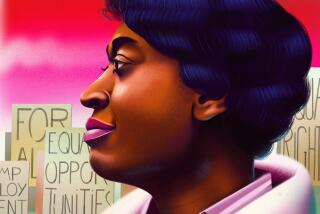Edward Smith; 81; Fought for Film Work for Black Stuntmen
Edward “Eddie” Smith, who co-founded the Black Stuntmen’s Assn. in 1967 and fought to generate jobs for African American stuntmen in Hollywood, has died. He was 81.
Smith, who had various illnesses, died June 24 at a nursing home in Culver City, said his wife, Denise Shaw Smith.
Over the years, Smith worked as a stuntman or stunt coordinator on numerous television shows and films, including “MASH,” “Dirty Harry,” “Beneath the Planet of the Apes,” “Blazing Saddles,” “Earthquake,” “Scarface,” “The Nutty Professor” and the TV miniseries “Roots.”
He also took pride in being the only African American stunt coordinator on the 1973 James Bond movie “Live and Let Die.”
But it was in his little-recognized role in launching the Black Stuntmen’s Assn. and helping break through the color barrier in the stunt business that Smith had the most effect.
Although it was his idea to start the organization, he was never interested in being president or holding any other office in the group
“He just wanted to be the fighter” for jobs, stuntman Henry Kingi, one of the association’s co-founders, told The Times.
A native of St. Louis, Smith began working in Hollywood in 1955 as a film extra and freelance TV news cameraman covering breaking stories for local stations.
The seed for creating a black stuntmen’s group was planted when he was an extra on the star-filled 1963 comedy “It’s a Mad Mad Mad Mad World” and saw a white stuntman being made up to be the stunt double for black actor Eddie “Rochester” Anderson.
Known as a “paint-down,” it was a common practice for a white stuntman to be made up in the appropriate shade whenever an actor of color needed to be doubled.
But the practice became even more controversial in the 1960s, when an increasing number of African American and other minority actors began to gain roles in films and on television.
The “paint-down” practice, Smith believed, was not only insulting but also prevented nonwhites from tapping a potentially lucrative source of income as stuntmen.
“A white stunt guy would say, ‘I had a pretty good week. I guess I’ll go down to Palm Springs,’ ” Smith recalled in a 2002 interview with The Times. “And I’d think, ‘I ain’t made enough money to take the Red Car to Watts.’ ”
When Smith complained to director Stanley Kramer on the “Mad World” set and asked why a black stuntman wasn’t doubling for Anderson, Kramer is said to have replied, “Well, find me one.”
As Smith later recalled: “Man, I couldn’t get no brothers nowhere. But I told him, ‘Next time, I’ll be able to supply you with what you want.’ ”
The association was founded after Smith asked Kingi and his fellow re-enactors of the all-black U.S. 10th Cavalry Unit, better known as the Buffalo Soldiers, if they would like to become stuntmen.
Joined by extras and former athletes, Smith and the others began training in Athens Park in South Los Angeles.
“We’d meet there and practice fight scenes,” recalled Kingi, “and we’d get a bunch of bed mattresses and practice falls off the backstop of the baseball diamond or run and jump over the back of the bleachers into the pads.”
As they trained, he said, they would see police officers in unmarked cars watching them from across the street.
“They thought we were some kind of militant group,” Kingi said with a laugh.
Members of the fledgling association went on to practice stunts on motorcycles and in cars on vacant lots and dead-end roads.
At one point, two top white stuntmen, Glenn Wilder and Ronnie Rondell, co-founders of Stunts Unlimited, helped them train. But many white stuntmen, concerned that they would be losing jobs to African Americans, were not supportive.
And getting white stunt coordinators, who controlled the hiring, to give the black workers a jobs was a struggle.
Smith led that struggle.
“He always had his ear to the ground to find out what was going on, so anything that was not being done as it should could be rectified,” Kingi recalled.
And, he said, Smith “had creative little ways about getting it done.”
“There were times when something would happen, so he would call up the studio [posing] as the Negro Press, and he’d call back as maybe the African American National Press, and he’d be several different presses to get them to listen, and then we’d go in and talk with them,” Kingi said.
When Smith discovered that a white stuntman had been called in to double for African American Louis Gossett Jr. on the 1971 Warner Bros. western “Skin Game,” Smith argued that the job could be handled by black stuntman Tony Brubaker.
As recounted in a 2002 Times story, the National Assn. for the Advancement of Colored People, the Equal Employment Opportunity Commission and the Screen Actors Guild were drawn into the controversy.
Warner Bros. soon agreed not only to hire black stunt people to double for black actors but also to include black stuntmen in all scenes involving general stunt work. In addition, the studio invited black stuntmen to train with veteran white stuntmen.
Labeled troublemakers because of their activism, association members said they frequently found that stunt jobs went to black stuntmen who were less vocal.
“Eddie would tell us different studios would try to buy him off -- give him jobs to quiet him down -- but he would basically have to give up the fight to do that, and he wasn’t willing to do that,” recalled Kingi. “You could trust that he would never sell you out.”
When Smith was one of two stuntmen injured in a helicopter crash during the making of “MASH” in 1969, he kept quiet about the pain from an injured leg, which left him with a lasting limp.
“I couldn’t mess it up for the rest of the group, man,” he explained in the Times interview. “We fought too hard. We had to show ourselves.”
In the same article, actor-director Sidney Poitier, who worked with black stunt people on “Uptown Saturday Night” and other films, said the Black Stuntmen’s Assn. made a contribution “that is all too often not remembered or recognized by the industry.... They were quite a force, and they were substantive in their skills and their contributions.”
Although he officially retired from stunt work in 1996, Smith continued to work regularly as a recruiter of African American extras for film and TV shows.
Kingi said the association phased out some time ago as a number of black stuntmen joined “white stunt groups they couldn’t get into before.”
But although black stuntmen are being hired today, Kingi said, an activist group like the Black Stuntmen’s Assn. would still be beneficial today.
“It’s still moving sand, basically: You move it and make some progress, you step back and it slides back into the hole,” he said. “So it’s a constant battle, even though there’s lip service to say it isn’t.”
But in Smith’s time, Kingi said, “He would sit and see those things happen, and then he would want to go and do something about it.”
In addition to his wife, Smith is survived by numerous children, grandchildren and great-grandchildren.
More to Read
The biggest entertainment stories
Get our big stories about Hollywood, film, television, music, arts, culture and more right in your inbox as soon as they publish.
You may occasionally receive promotional content from the Los Angeles Times.










